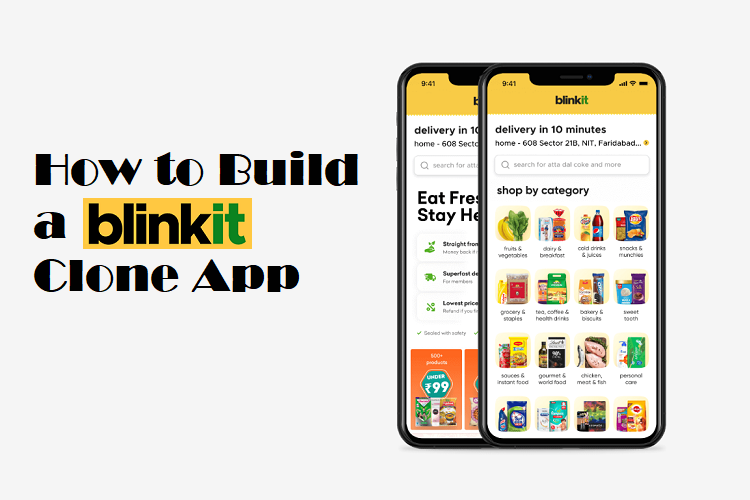With the technological advancements of the modern world, comfort has become a top concern for consumers. Thanks to a digitalized world, customers are no longer satisfied with things they must visit a physical store or branch for. Still, they can have every service available instantly by clicking on an icon on their smartphone.
Such an increase in the willingness of a customer to buy online has allowed the opening of an online grocery delivery market where convenience and efficiency are in one basket. Blinkit has uniquely distinguished itself among the many other participants in this industry as a great demonstration of its successful growth and popularity within a short time.
Blinkit’s success story is exhilarating and proof of the online grocery delivery model. The company’s hassle-free workings, well-managed logistics, and customer-centricity have made it an attractive model for entrepreneurs worldwide. Many traditional grocery store owners are now seeking to replicate Blinkit’s success by launching Blinkit clone apps, which mainly fulfill the requirements of modern customers.
The blog will explore the depths of developing a Blinkit clone app. From Blinkit’s origin to its working strategy, we will give a well-researched and detailed guide to those interested in the online grocery delivery market. Whether you are a start-up or a well-established enterprise, this guide will assist you in developing a Blinkit-like app that meets customers’ current needs.
What is Blinkit?
Blinkit is a fast-expanding company offering online grocery delivery services that meet consumers’ preferences, focusing on convenience and time optimization. This Indian startup has gained recognition due to its innovative solutions and customer-oriented services. It is quickly gaining popularity among postmodern customers.
- Founded in: 2013
- Origin: Gurugram- India
- Founders: Saurabh Kumar, Albinder Dhindsa
- Area Served: 23+ Indian Cities
- Parent Company: Grofers International Pvt. Ltd.
Company Highlights
- The Blinkit application allows customers to buy and even order their products at a specific time. Grofers employees will deliver the items to the customers. At present, the company is already operational in 23 cities in India as Blinkit.
- Over 10 million Indians use Blinkit as their preferred method of buying groceries, vegetables, emergency supplies, and electronics.
- Currently, Blinkit delivers more than 125,000 orders per day and is committed to bringing the next generation of commerce everywhere in India.
Data and statistics show that Blinkit has had notable success providing online grocery delivery services. Its fast growth ignites the emerging entrepreneurial spirit of those willing to ride on the wave of the thriving market and deliver cutting-edge solutions.
Blinkit’s smooth service and customer-oriented business model have established the standard of quality in the market; therefore, competition has risen among the players in the industry, leading to more innovation in the trade environment.
What is Blinkit Clone?
A “Blinkit clone” is a replicated version of the “Blinkit” app but has all the contemporary features to enable entrepreneurs to operate an online grocery delivery business efficiently.
A ready-made Blinkit clone script differs from custom grocery delivery apps because it already has all the significant functionalities thanks to the ready-to-plug modules. Hence, startups will not have to worry as they will save time and resources.
The advantage of a Blinkit clone is the cost-effectiveness of launching the startups, which helps with earlier entrance into the market where limited development costs are required. The online grocery delivery market is growing fast. Businesses can quickly get to the race by using ready-made clone scripts to offer customers convenience and efficiency while optimizing operational processes.
Blinkit’s Lightning-Fast Grocery Delivery: Cracking the Business Model in 10 minutes!
Regarding the fierce competition in online grocery delivery, Blinkit’s standout attribute is its capability to supply items within the shortest possible time of 10 minutes. Here’s a breakdown of how their business model enables this lightning-fast service:
- Hyperlocal Warehousing: The company chooses warehouses close to crucial locations so that customers’ distance from delivery can be reduced significantly.
- Efficient Inventory Management: Such data analytics, the principle behind inventory management, ensures the company quickens stock turnover while slowing down customer wait times.
- Predictive Algorithms: Deploy state-of-the-art algorithms that anticipate customer orders. Then, pick and pack items faster, allowing fulfilment to be completed in the shortest period possible.
- Dedicated Delivery Network: Blinkit utilizes a fleet of mono-purpose delivery personnel trained to deliver orders as fast as possible while preserving accuracy, resulting in improved efficiency.
- Real-Time Tracking: Customers can also monitor their order’s progress in real time, turn-by-turn, providing transparency and reassurance during delivery time.
By successfully blending technology, logistics, and customer focus, Blinkit is creating a new standard for speed and reliability in the online grocery ordering experience, thus transforming how people deliver groceries.
Step-by-Step Guide to Building an App Like Blinkit

Strategy is essential in starting an app business similar to Blinkit. It involves conducting deep market research to discover the nuances of the online grocery delivery segment, including customers’ tastes and place competitors.
This part will explore the vital stages that must be completed to create an app like Blinkit. Each stage is critical to achieving a reliable app’s performance in terms of both its functionality and user experience in a highly competitive online grocery delivery market. Following these sensible steps will eventually help you form an all-inclusive and user-friendly system that can face the challenges of modern consumers.
1. Discovery Phase
The Discovery Stage is basic but essential in an app development environment that is constantly changing. Through these avenues, businesses discover valuable information that drives the strategic process of their app creation undertaking.
- The most important thing is to know the market. The first step is conducting a functional analysis of the online grocery market.
- Think about the size of the market, projections for future growth, and any emerging trends that could help target your customers.
- Using demographic analysis, you can identify a very specific audience. Consider age groups, income brackets, regional regions, and lifestyles.
- Know who your customers are and what they do, including purchases, delivery times, and products they like. This data helps you custom design an app that aligns with customer expectations.
- Carrying out market research, user personas, and competitor analysis should form the basis of your knowledge of core features for the app’s success.
- Give prominence to the features considering their impact on user experience, importance, and technical feasibility.
Through these steps in the Discovery Phase, you will get vital insights; this makes you set clear objectives and act as a base for developing a successful app like Blinkit that suits your target market.
2. Planning and Pre-development Phase
In the Planning and Pre-development Phase, the conceptualization is transformed into accurate development plans for the app. This stage includes performing the most essential actions to create the groundwork for project implementation and achievement.
Here’s an overview of what this phase entails:
Project Scope Definition
- First, you will have to precisely draw the task’s boundaries, including the goal, target audience, features, time limits, and budget.
- Here, we work with stakeholders, collect requirements, and set boundaries to ensure the team follows the right vision and understands what is expected of them in the development process.
Technical Architecture Design
- Secondly, the app’s technical architecture is planned, and it includes selecting the application technology stack, setting up the infrastructure, designing the database, and integrating third parties.
- This face comprises the development of wireframes, mockups, and prototypes to render the app’s user interface and functions.
- The visualization process comes first to validate and get feedback at the development stage.
An efficient and comprehensive approach to the planning and pre-development phase enables businesses to avoid many pitfalls of the development process, reduce risks, and lay a solid foundation for the agile app launch that aligns with user expectations and the main business objectives.
3. Design of Blinkit Clone App
A minimalistic design concept is a must when self-analyzing a Blinkit clone app. Here, the effort is on making an interface that is simple, uncluttered, and has a user-friendly spontaneous user experience so that users can quickly navigate and access the most essential functionality.
Apart from its visual enhancement qualities, a minimalist design also enables a smooth and engaging user experience, enhancing product usability and retention. To achieve this, consider the following key elements:
- Simplicity: Simplify by decluttering and strictly focusing on the core features.
- Intuitive Navigation: Develop user-friendly navigation that is comprehensive enough to guide users through the app without making them look for it everywhere.
- Visual Hierarchy: Provide a clear visual hierarchy that emphasizes vital information and which actions apply.
Also, a focus on user-friendliness in developing a Blinkit clone app has to be of the utmost importance. The user interface (UI) and user experience (UX) must be created diligently to make using the product both easy and joyful. Adding user feedback and conducting usability tests brings the design to maturity, which thus results in a mobile application that users embrace and can’t help but come back for.
Prioritizing UI/UX considerations includes:
- Responsive Design: Provide cross-device compatibility in different displays and sizes for a uniform experience.
- Interactive Elements: Include activities that catch the learners’ attention and promote in-depth involvement and communication.
- Accessibility: Design the app with accessibility standards for the broadest user base in mind.
Developers who want to capture the appealing functionality and reach the satisfaction and usability pinnacles of the original app can consider the concept of designing and developing the app.
4. Develop and Test
The selection of the ideal tech stack is very important when developing the Blinkit clone app. It affects performance, scalability, and user experience in general.
Choosing integration tools that dovetail with the app functions is vital to maintaining a compelling and secure user experience simultaneously. Popular integrations for a Blinkit clone app may include:
By choosing the right tech stack, using budget-friendly means and well-thought integrations of third-party services, the developers can create the Blinkit clone app, which will effectively meet the users’ expectations and business objectives.
Next, the solution is tested using a procedure that checks the functioning, performance, and safety level. One of the crucial steps of app development is the final testing, through which the developers can reveal and fix the bugs or intrinsic deficiencies of the app before it goes on the market.
5. App Launch and Promotion
The app is ready and available in app stores. You launch your promotion campaign to attract users and collect feedback for its future development. Here are some ways to promote your app:
- Paid Ads: Use ads on Facebook, Google, and Instagram to get your ads exposure to more people.
- Social Media Marketing (SMM): Make social media work for you and, like that, let your app be known to your target audience.
- Influencer Marketing: Working with influencers can help you to expand your audience and publicize your app.
- Content Marketing: Use content marketing, blog writing, creating UGC content, and more to gain visibility and business recognition.
These methods could lead you to achieve more customers and grow the market share of your app.
What is the Development Cost of Building an App Like Blinkit?
The convenience of having everyday essentials delivered right to your door is a dream come true for many consumers who place on-demand orders and for many business owners hoping to stay competitive in a booming sector. The question on everyone’s mind, regardless of the class this would-be entrepreneur belongs to, is how much it will cost to create an on-demand grocery app.
The intricacy of the online grocery delivery app, the platform you select, and the location may all be used to determine its final cost because the cost of producing an app varies by nation. For a single platform, the estimated cost of the grocery delivery app will be between $10,000 and $30,000.
The on-demand grocery delivery industry will grow rapidly in the next few years. Therefore, businesses that intend to enter this industry should be aware of the range of expenses associated with creating a Blinkit-like app.
Conclusive Thoughts
Grocery delivery apps will make grocery shopping easier for everyone in 2024. They include easy-to-follow instructions, affordable prices, and cool features. Thanks to their cutting-edge features, efficient development processes, and open-cost structures, these apps have become essential daily companions.
Your traditional business operations will reach new heights with Blinkit-like trendy grocery app development or q-commerce app development, whether you choose a multi-vendor or single-vendor model.


